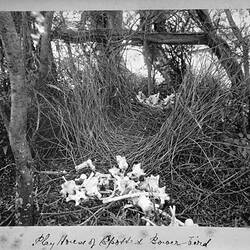SPOTTED BOWER BIRD (Chlamydera maculate, Gould)
Geographical Distribution - Queensland, New South Wales, Victoria, South Australia.
Nest - Flat, somewhat concave; loosely constructed of dead twigs or fine sticks; lined inside with finer twigs and grass; usually situated in a thick bush or tree in open forest country. Sometimes the nest is so frail that the contents may be seen through the structure from underneath. Dimensions over all of a good nest, 9 to 10 inches by 6 inches in depth; egg cavity, 4 inches across by 2 inches deep.
Eggs - Clutch, two, occasionally three; shape inclined to oval, or long oval; texture and shell fine; surface slightly glossy; ground-colour light greenish-yellow. There are three distinct characters of markings, firstly, light-greyish blotches appearing on the inner surface of the shell; secondly, small stripes or hair-like lines of light-sienna and umber, as if painted with a camel-hair brush, in every shape and size round shell, principally zig-zagged latitudinally, but often taking longitudinal and other directions; and, lastly, over these a few darker and heavier stripes and smudges of umber. Both ends of the eggs are comparatively free from markings. Dimensions in inches of a proper clutch: (1) 1.64 x 1.04, (2) 1.63 x 1.05, (3) 1.55 x 1.04; a pair with more of the yellowish-white ground, and with both ends much freer from markings, measures (1) 1.57 x 1.06, (2) 1.5 x 1.07. (Plate 9.)
The eggs are very beautiful and most singular in appearance, resembling fine porcelain with hand-painted markings.
Observations - The beautiful spotted Bower Bird is a dweller of the dry interior provinces.
In a Riverina timber belt, how venerable and dark the cone-shaped pines (Callitris) appear, with every branch and branchlet, dead and living, bedecked with ornamental lichens! Their sombre character is relieved by the interspacing silvery, needle-like foliage of hakea trees of lower growth, bearing a crop of curiously-fashioned seed-balls; a species of acacia with short stiff leaves and with the wood not unlike the West Australian jam-wood for aroma, by its floral stores is celebrating "Yellow-haired September;" the quondong tree (Santalum), whose pendulous foliage clings likes skirts about its dark rough stem, is also seen, besides other dwarf trees called by lengthy botanical names; while all around the rich, red ground, well-grassed, sparkles with the flowers of small white immortelles, - such is the home of the Spotted Bower Bird as I saw it once in spring.
There has been some discussion as to who first found the genuine eggs of the Spotted Bower Bird. I believe (and it is only my belief , without any direct proof, and therefore I am open to correction) that some of the earlier recorded finds, especially those on the coast of the northern portion of New South Wales, were none other than the eggs of the Regent Bird (Sericulus melinus). These coastal scrubs are the stronghold of the Regent Bird, whereas the Spotted Bower Bird, as I have stated, seeks generally the dry and arid parts of the interior. I have also the testimony of a keen observer inn the former locality that the Spotted Bower Bird is scarce there. Moreover, nothing would b e easier, at first sight, than to mistake a female Regent Bird for a Spotted Bower Bird when flushed from the nest. Probably the first discovered egg of the Spotted Bower Bird was obtained by Mr. A. N. Foot, in Queensland, and was exhibited by Dr. G. Bennett, of Sydney, at a meeting of the London Zoological Society, held 3rd June, 1873.
Another of the first authenticated eggs discovered of the Spotted Bower Birds found by Mr. J.B. White, and described by Dr. Ramsay, vide Proceedings of Zoological Society, 1874. The same year (1874) Mr. Hermann Lau discovered a nest of this Bower Bird near Whitstone, South Queensland. I shall quote his original and interesting note:-
'This bird makes for the fruit when it ripens in the garden, especially the figs. The scrub, where it comes from, grows on a sandy bottom in the neighbourhood of the station. In this scrub I several times espied the bower of the bird, not like the edifice of the Satin Bird, which is closed on the top, but open. A cartful of bones* - the vertebrae of sheep predominating - pieces of glass, unripe wild fruit, even a shilling, sometimes betray the entrance of the bower.
'While bathing one afternoon in M'Intyre Creek, half-a-mile from the scrub, I observed a Bower Bird flying with a caterpillar in its bill. After dressing, I followed in the direction, and found its nest high in a tea-tree (Melaleuca) over the water, and procuring a ladder, beheld two young in the nest. Eventually I took the nest and young home, feeding the young for two months, as long as the season lasted, but at last they died.
'At the same place (Whitstone) I again got a nest with two eggs. December 1874. The nest represents small sticks, like that of a pigeon, but lined with grass, &c.'
When Mr. Lau was returning to his fatherland, this particular nest and eggs found a secure resting-place in the beautiful collection of Mr. D. Le Souëf, at the Royal Park, Melbourne.
About the end of October, 1877, while searching for specimens along a billabong f the River Darling, not far from Wentworth, New South Wales, I found a nest, about twenty feet from the ground, near the top of a red gum (Eucalyptus) sapling in a belt of timber. A bird (probably the hen) was sitting, and did not leave until I had climbed close to it. The nest was loosely composed of sticks and twigs, and lined inside with finer twigs and grass, and contained one fresh egg, the most remarkable for beauty and wonderful character of it is markings that it has ever been my fortune to find.
A nest of the Spotted Bower Bird was pointed out to me, from which a pair of beautiful eggs was taken on the 14th November, 1894. The nest was the usual frail structure, built at the height of about thirty feet from the ground, near the top of a pine tree (Callistris). The tree was situated about two hundred yards from a dwelling on Neimur Creek, Riverina, and was discovered by one of the lads tracking the bird while carrying a twig to construct its nest. The eggs, which are a light-coloured type, are now in the collection of Mr. Joseph Gabriel, Abbotsford, Victoria.
The Spotted Bower Bird occasionally lays three eggs. Mr. R. MacFarlane, formerly of the Mallee Cliffs Station, New South Wales, found a nest containing three eggs in a needle-bush (Hakea). While the specimens awaited a favourable opportunity to be sent to Melbourne for my collection, the station cook it, is supposed, took a fancy to them, for they somehow mysteriously disappeared. Again, Mr. W. L. Hutton, writing to me from Lessington, near Bourke, says: - 'I saw three nests of the Bower Bird last season (1895), one of which had three eggs in it.' In Queensland, Mr W.B. Barnard found on the 12th December, 1897, an exceedingly handsome set of three eggs, now in my collection. The following is Mr. Barnard's field note concerning them: - I was travelling with a mob of cattle, and while coming through Moura run I found the nest in a sandal-wood tree, about fifteen feet from the ground. I could see the eggs through the nest from underneath. The old bird seemed shy, as she would not come near. Later in the day I found another nest, but it contained three young half-fledged. The nest was in a brigalow (species of acacia), about thirty-five feet from the ground.'
The note of the Spotted Bower Bird is somewhat harsh and scolding. But it is not generally known, nor has it been properly recorded, that these birds are accomplished mocking creatures, as several of my bush friends can attest. The Misses Macaulay, of 'Bannockburn,' Riverina, had one or two birds which, at certain seasons, regularly between ten o'clock in the morning and two in the afternoon, used to visit the pepper trees in the garden, where the birds were heard imitating the calls of the noisy Miner (Misantha), Magpie (Gymnorhina), the Raven, but not quite so hoarsely, and Babblers (Pomatostomus); while the screech of the Whistling Eagle was so realistic as to cause a domestic hen and chickens to fly for cover, although no bird of prey was nigh. The Bower Bird also reproduces well the sound of a maul striking the splitter's wedge, and other familiar sounds, such as the mewing of cats, barking of dogs, &c.
Mr. G. H. Morton, of Benjeroop, relates an amusing experience regarding the mimicry of the Spotted Bower Bird. His neighbour had been driving cattle to a given place, and on his way back discovered a nest in a prickly needle-bush or hakea tree. In 'threading' the needle branches after the nest, he thought he heard cattle breaking through the scrub, and the barking of dogs in the distance, and at once fancies his cattle had broken away, but could see no signs of anything wrong. He heard other peculiar noises, and glancing at his dog, as much as to say, 'What does that mean?' he saw the sagacious animal, with his head partly upturned, eyeing a Bower Bird perched in the next tree.
Although Gould has cleverly described the bower of this species, and, moreover, succeeded in taking one to England, which is now in the British Museum, and other authors have mentioned these wonderful creatures, without unnecessarily extending the present observations I may state that during our memorable 'flood' trip through Riverina, September, 1893, Mr. J. Gabriel and I embraced the opportunity of examining on the Pine Ridges six of the avenues or playing-grounds - all apparently in use - of the Spotted Bower Bird. Some of these singular structures we successfully photographed. They were under bushes, usually the prickly bursaria, and consisted of a pair of parallel walls of sticks, grass, &c., stuck into the ground on end, and heaped about wit bones, chiefly placed about either entrance. I give details of three of these bowers, which may be taken as types.
Under a clump of bursaria bushes, with thistles and other vegetation grown near - platform or approach larger at one entrance. Space immediately around the bower and centre of avenue-like walk composed of dead twigs, well trampled down. Exterior portion of walls composed of twigs; interior side of walls composed of yellowish grass stalks, with the seedling parts uppermost. Number of bones - leg bones, ribs, and vertebrae of sheep - ninety at one entrance, ninety-two at the opposite. Inside the bower were twenty-four bones. Other decorations inside and round about were - pieces of glass, twenty-four; hakea seeds, thirty; quondong (Santalum) seeds, four; and green pine branchlets, two.
At the edge of the mallee (species of Eucalyptus) scrub, under bursaria bushes, with pines and bull-oaks (Casuarina) near. Bones placed just at entrances; bower somewhat open, and concaved towards the centre of the floor; built principally of a species of coarse tussocky grass and casuarina needles or foliage. (See illustration.)
Situated under native hop bush, and slightly curved in shape; principally constructed of coarse tussocky grass and casuarina needles, with a few branching twigs placed outermost. Usual heap of bones at either entrance, also bits of glass, quondong, hakea, and other seeds, portions of pig-face weed (Mesembryanthemum), pieces of Emu egg-shell, &c. In centre a handful of bones (fifteen) and quondong seeds (eight).
Statement showing the dimensions in inches of three ordinary-sized play-grounds or bowers of the Spotted Bower Bird:-
Total Length of Play-Ground
62
42
63
Length of Bower
17
18
27
Breadth of Bower from Outside Walls
20
16-17
27
Width Inside
6-7
7-8
6-9
Height of Walls
15
12
10-12
Thickness of Walls
5-6
4-5
8-9
Lost jewellery, coin of the realm, &c., have often been recovered at bowers. It is said that any decorations of the bower by human hands is resented by the birds, the items, however beautiful, being thrown out. However, if the bones, &c., belonging to the bower be scattered, the birds will always gather them together again.
It has always been stated, but I have not been able to verify it, that this Bower Bird discriminates colours, and that it will carry nothing of a bright-red nature to its play-ground.
With reference to Gould's C. occipitalis, Dr. Ramsay, who has examined the type, pronounces it to be only a fine-plumaged adult male of C. maculata.
Resources
Transcribed from Archibald James Campbell. Nests and Eggs of Australian Birds, including the Geographical Distribution of the Species and Popular Observations Thereon, Pawson & Brailsford, Sheffield, England, 1900, pp. 198-202.
More Information
-
Keywords
-
Authors
-
Contributors
-
Article types



